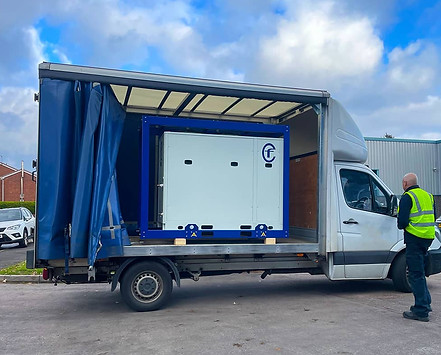How Do Water Cooled Chiller Units Work?
01. Evaporation
Water circulates and absorbs heat from your equipment or process and is then directed to the chiller’s evaporator. This warm water passes over a series of tubes containing the refrigerant liquid and the heat is transferred, causing the refrigerant to evaporate, and allowing the water to continue the cooling process.
01. Evaporation
Water circulates and absorbs heat from your equipment or process and is then directed to the chiller’s evaporator. This warm water passes over a series of tubes containing the refrigerant liquid and the heat is transferred, causing the refrigerant to evaporate, and allowing the water to continue the cooling process.
02. Compression
Now carrying heat absorbed from the water, the refrigerant now moves to the compressor. To prepare it for the next stage of the process, the compressor increases the pressure of the refrigerant, which also raises its temperature.
02. Compression
Now carrying heat absorbed from the water, the refrigerant now moves to the compressor. To prepare it for the next stage of the process, the compressor increases the pressure of the refrigerant, which also raises its temperature.
03. Condensation
In the condenser, the refrigerant which is now a gas passes through coils or tubes which are circulated by water from an external cooling tower. The cooler water absorbs the heat from the refrigerant gas, allowing it to condense back into a liquid, and this heat is released into the atmosphere.
03. Condensation
In the condenser, the refrigerant which is now a gas passes through coils or tubes which are circulated by water from an external cooling tower. The cooler water absorbs the heat from the refrigerant gas, allowing it to condense back into a liquid, and this heat is released into the atmosphere.
04. Expansion
For the last stage of the water chiller system, the high-pressure liquid refrigerant passes through an expansion valve. Its pressure drops which cools the refrigerant turning it back into a cold, low-pressure liquid. This cold refrigerant is then sent back to the evaporator to absorb more heat from the process water.
04. Expansion
For the last stage of the water chiller system, the high-pressure liquid refrigerant passes through an expansion valve. Its pressure drops which cools the refrigerant turning it back into a cold, low-pressure liquid. This cold refrigerant is then sent back to the evaporator to absorb more heat from the process water.
The Benefits of Industrial Water Cooling with CF Chiller
Energy Efficiency
Industrial water cooling systems are typically more energy-efficient, especially in larger applications. They use less electricity to achieve the same cooling capacity, which results in significant cost savings over time.
Space-Saving Design
Unlike air-cooled systems, water-cooled chillers do not require large external units. This makes them ideal for locations with limited space or where the appearance of the commercial water cooling unit is important.
Longevity and Reliability
Water chiller machines generally have a longer lifespan due to their stable operating conditions. With proper maintenance, these systems can provide reliable cooling for many years, reducing the need for frequent replacements.
Quiet Operation
Water-cooled chillers are quieter than some of their counterparts because they do not rely on large fans for cooling. This makes them suitable for noise-sensitive environments such as office buildings and certain types of entertainment venues.
Environmentally Friendly
Because they use water as their primary cooling method, water cooled chillers reduce the environmental impacts that come with refrigerants. They also have a lower carbon footprint compared to air-cooled systems.





